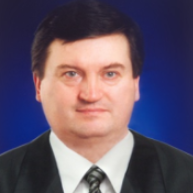
Viktor Legeza
Work place: National Technical University of Ukraine “Igor Sikorsky Kyiv Polytechnic Institute”, Ukraine
E-mail: viktor.legeza@gmail.com
Website: https://scholar.google.com/citations?hl=en&user=3CP7yP4AAAAJ&view_op=list_works&sortby=pubdate
Research Interests: Statistical mechanics, Mathematics of Computing, Mathematics, Physics & Mathematics
Biography
Viktor Legeza is a full time professor, and a Doctor of Science, professor in the Departament of Computer Systems Software at the National Technical University of Ukraine – Igor Sikorsky Kyiv Polytechnic Institute, Ukraine. He graduated from Cybernetics of National Research Nuclear University "Moscow Engineering and Physical Institute" (MEPhI), specializing in "Applied Mathematics". He is the author and co-author of over 270 scientific works, including two monographs and seven textbooks for High Schools on mathematical disciplines. More than 70 of his scientific publications are quoted in such databases as Scopus, Web of Science, Research Gate etc. The results of scientific research are protected by more than 65 patents. Areas of major scientific interest: mathematical modelling of dynamic processes in coupled systems, applied problems of vibration and seismic load-bearing objects, the dynamics of railway transportation, shock protection in transport, identification of objects, nonholonomic mechanics, patenting inventions.
Author Articles
Geodesic Curves Simulation on a Transcendental Surface with a Cycloidal Generatrix Using the Calculus of Variations
By Viktor Legeza Liubov Oleshchenko Andrii Dychka
DOI: https://doi.org/10.5815/ijisa.2025.04.02, Pub. Date: 8 Aug. 2025
This article introduces a novel variational approach for solving the inverse geodesic problem on a transcendental surface shaped as a cylindrical structure with a cycloidal generatrix, a type of geometry that has not been previously studied in this context. Unlike classical models that rely on symmetric surfaces such as spheres or spheroids, this method formulates the geodesic path as a functional minimization problem. By applying the Euler–Lagrange equation, an analytical integration of the corresponding second-order differential equation is achieved, resulting in a parametric expression that satisfies boundary conditions. The effectiveness of the proposed method for computing geodesic curves on transcendental surfaces has been rigorously evaluated through a series of numerical experiments. Analytical validation has been carried out using MathCad, while simulation and three-dimensional visualization have been implemented in Python. Numerical experiments are conducted and 3D visualizations of the geodesic lines are presented for multiple point pairs on the surface, demonstrating the accuracy and computational efficiency of the proposed solution. This enables a closed-form analytical representation of the geodesic curve, significantly reducing computational complexity compared to existing numerical-heuristic methods.
The obtained results offer clear advantages over existing studies in the field of computational geometry and variational calculus. Specifically, the proposed method enables the construction of geodesic curves on complex transcendental surfaces where traditional methods either fail or require intensive numerical approximation.
The analytical integration of geodesic equations enhances both accuracy and performance, achieving an average computational cost reduction of approximately 27-30% and accuracy improvement of around 20% in comparison with previous models utilizing non-polynomial metrics. These enhancements are especially relevant in applications requiring real-time response and precision, such as robotics, CAD systems, computer graphics, and virtual environment simulation. The method’s ability to deliver compact and exact solutions for boundary value problems positions it as a valuable contribution for both theoretical and applied sciences.
Non-Linear Model of the Damping Process in a System with a two-mass Pendulum Absorber
By Zhengbing Hu Viktor Legeza Ivan Dychka Mykola Onai
DOI: https://doi.org/10.5815/ijisa.2019.01.07, Pub. Date: 8 Jan. 2019
In this paper, the dynamic behavior of the damping system is analyzed with a two-mass pendulum absorber, the equations of motion of non-linear mechanical systems are built accordingly. AFC equation systems have been identified in the non-linear formulation. To obtain the frequency response, the Ritz averaging method is used. A new numerical method of determining the parameters of optimal tuning two-mass pendulum absorber in the non-linear formulation has been Proposed and implemented.
[...] Read more.Mathematical Model of the Dynamics in a One Nonholonomic Vibration Protection System
By Viktor Legeza Ivan Dychka Ruslan Hadyniak Liubov Oleshchenko
DOI: https://doi.org/10.5815/ijisa.2018.10.03, Pub. Date: 8 Oct. 2018
Dynamic behavior of a heavy homogeneous sphere in a spherical cavity of a supporting body that performs specified translational movements in space has been studied. Using the Appel formalism, the equations of ball motion in a moving spherical cavity without slip are constructed and a numerical analysis of the evolution of the ball motion is carried out.
[...] Read more.Mathematical Model of the Damping Process in a One System with a Ball Vibration Absorber
By Zhengbing Hu Viktor Legeza Ivan Dychka Dmytro Legeza
DOI: https://doi.org/10.5815/ijisa.2018.01.04, Pub. Date: 8 Jan. 2018
The forced oscillations of the damping mechanical system of solids "Ball Vibration Absorber (BVA) with linearly viscous resistance – a movable carrier body" under the influence of external harmonic excitation are considered. Based on Appell's formalism, the dynamic equations for the joint motion of a heavy ball without sliding into a spherical cavity of a carrier body are formulated and numerically studied. The amplitude-frequency characteristic of the damping mechanical system and the curves of the dependences of the maximum amplitude of the oscillations of the carrier body on the values of the radius of the spherical cavity and the coefficient of viscous resistance of the BVA are obtained. The conditions and restrictions on the rolling of a heavy ball in the spherical recess of the absorber without sliding are determined.
[...] Read more.Other Articles
Subscribe to receive issue release notifications and newsletters from MECS Press journals